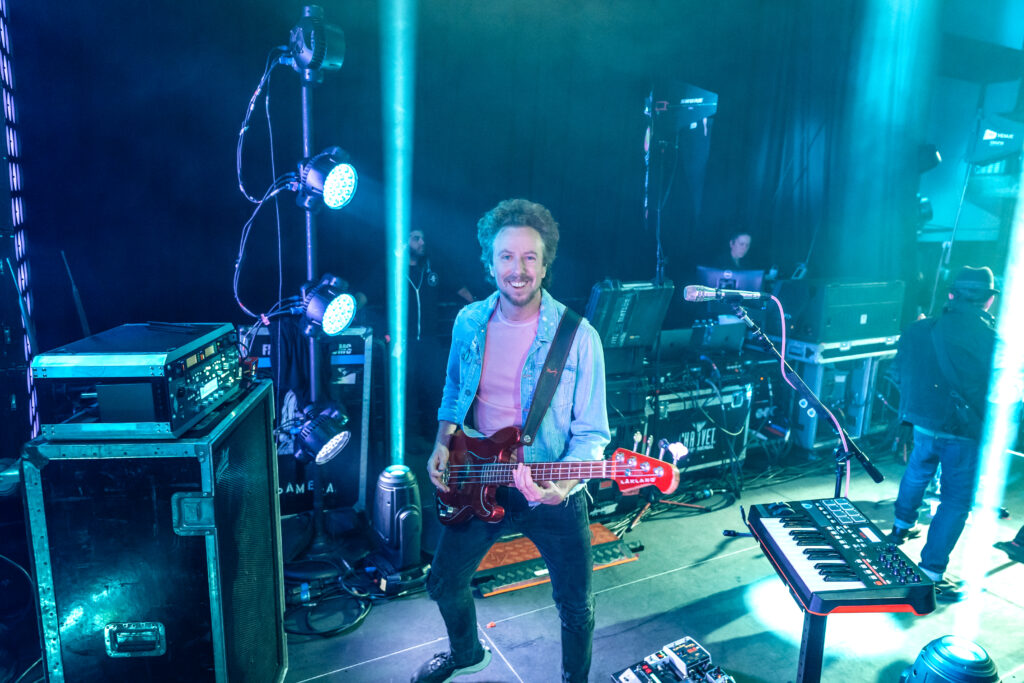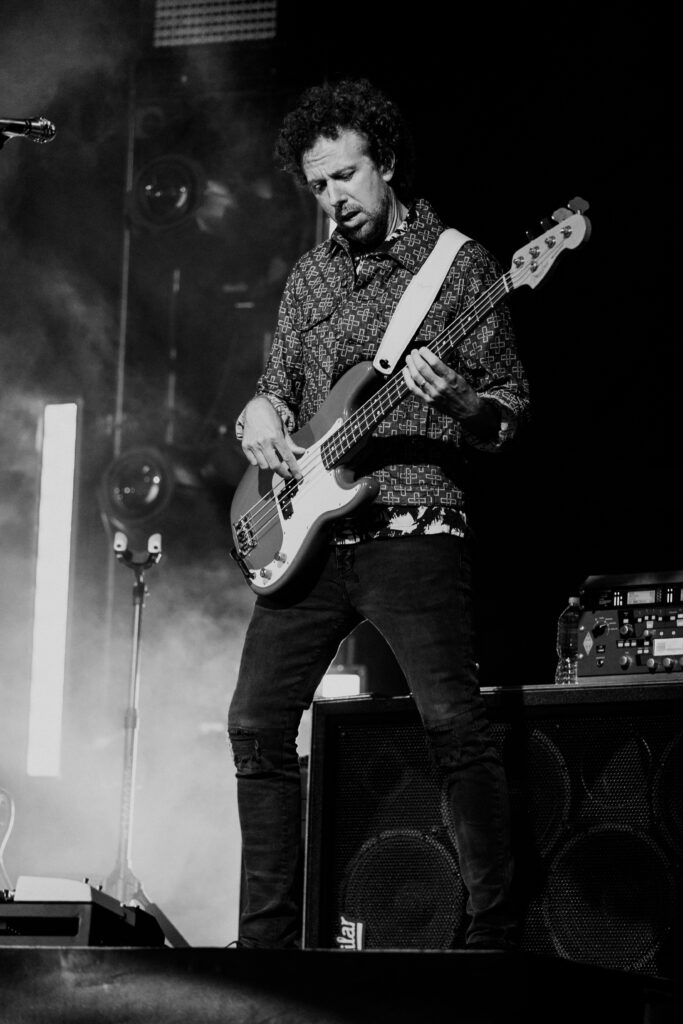Joseph Karnes has been playing with Fitz and the Tantrums since 2010, just before the release of their debut album. Since then, the band has released five albums that merge Indie Pop with Neo Soul and Dance elements. Guitars are rarely used, which gives the bass more focus as well as the keyboards and the saxophone. Songs such as HandClap, The Walker, and Out of my league have reached between 20 and 100 million clicks on YouTube meanwhile. After a pandemic break, the band has scheduled several dates in the US for 2023. We spoke to Joseph who uses the Kemper Profiler in his live rig. Another proof that the unit is not only meant to be used with guitars.

Joe, thanks for taking the time. How long have you been using the Profiler?
I have actually known about the Profiler for a long time. My brother-in-law Jared Scharff plays guitar and was in the band for the Saturday Night Live TV show for about 13 years. When he came to Los Angeles for a visit, he brought the unit and we did some recordings and even some profiles. It was my first experience, but we mainly used it with guitars back then and only plugged in a bass a couple of times.
Then in the Summer of 2019, we were on tour with Young The Giant. Both guitarists and their bass player had switched over to a Profiler. It was actually the first time I heard it being used with a bass live. I listened to the sound with the FOH engineer Aaron Glas and was immediately convinced by the clarity and the tone. This is especially true, as Payam Doostzadeh (bass player of Young The Giant) brought some really cool and rare basses with him, for example, a Harmony H22 semi-hollow instrument. The Profiler really reflected his instrument’s tones and each song sounded unique.
Until then, we always used a DI in addition to an amp and with a mic’ed cabinet. So I asked our engineer about the ratio of both signals. It turned out that there was more DI-signal present as the venues were pretty large. Our singer Fitz keeps one ear out from his in-ear-monitoring. This is why he needs some sound from the stage as well and one of the reasons why I always had a cabinet on stage. However, depending on the venue, the amp had to be turned up or down which obviously affects the cabinet level. We realized how much more control and consistency you would have when using the Profiler, especially if you use an amp sound. In addition, it felt really tempting to have all these profiles at hand in order to shape my sound.
These days, the Profiler is part of our fly gig rig. It became so important to my sound that I always bring it and rent a cabinet at the venue. And if the rental place has a Profiler, there’s a backup available. But I feel that bringing my own unit is always safer and faster.

Do you tweak your profiles depending on the song and the instrument?
Absolutely. I grabbed some free profiles, bought a few, and eventually got into doing some profiles on my own. I have a cool 370 head by Acoustic from the seventies which is one of my favorite solid-state amps, although it actually sounds like a tube head. It’s the brother of the 360 which all of my favorite players were using such as John Paul Jones, Aston “Family Man” Barrett, and Jaco Pastorius. The 360 was the standard back then, but had the power section in the cabinet which was certainly no option for me. Another amp I profiled is an Ampeg B15 from the early seventies. I could probably do better as I didn’t record in the best room or with the best microphone, but these profiles work. So I have a staple of probably five to ten profiles which I mainly use along with a DI signal. I know which amps will work for me with a certain play style. Sometimes I need a finger-style Motown-type of sound and sometimes I use a pick. For the latter, I will use an additional external EQ pedal to boost the upper mids and top end to get the sound to speak. This is because we play along to tracks on some songs and I would often be supplemented by a synth bass, and I therefore do not need as many low frequencies on those songs. I also use a lot of pedals anyway.
So yes, I may use a couple of scene changes within a song. On “HandClap” I use a pretty simple sound with some pushed gain. I created that tone fully within the Profiler.
To summarize: I would say that I have five main profiles: an Ampeg B-15 Clean for finger styles, a Dirty B-15 when using a pick or for a more aggressive sound, and a choice of early Fender Bassman profiles for fingerstyle. On a few songs I will use the Acoustic 370 profile I made myself as well as my own B-15 profile. And if am going for a rock sound, I will select something like an Ampeg SVT, but that’s rare in our set.
Actually, I really would like to explore the possibilities to sculpt your basic tone sound further. Currently, I typically select an amp profile and then tweak the gain and the EQ for that song.

Do you use your own profiles plus a choice of pedals to make your sound?
Not only my profiles. I often use other profiles, which were probably done more professionally. Among them is a Fender Bassman and a more dirty Ampeg B-15. This is my main choice, but over time, I may do some changes. If you play a song with the same sound for two years, you may get tired of it. So I would start tweaking it a little.
However, my Profiler is in my tour rig which is stored away. I got mine in 2019 and the last tour in Winter 2020 was cut up by the pandemic. That was also when my brother in law was living with us during lockdown – luckily with his Profiler. But I certainly need a Profiler at home to do more tweaks.
Did you use the Profiler for the album last year?
No, I didn’t pull it out for the studio. I had just gotten my B-15 and we did a more traditional recording. And on occasion, we didn’t use an amp at all but went directly into the console. We ended up with some fantastic tones …
You could have captured these with the Profiler
That would have been an amazing idea. We were pretty pressed on time though. I often only had few hours each day and we spent it all on recording. So far, we rarely ever had more than a whole week to record an entire album.
I am guessing a lot of sound tweaking happens in the mix, doesn’t it?
Definitely, especially if you also use a synthesizer. And the same is true for live. I trust our mixing engineer. He records every show and uses it during soundcheck to get the sound right. This is where I get out and take a listen. Once you get the Profiler to a certain sound, it will be real consistent. This is certainly helpful for the engineer as he always needs to adjust to the venue, too. In larger indoor places you may have several bass traps as low frequencies are a main problem. These places are the hardest to make them clean and thick sounding as you have to deal with issues such as waveform cancellation. I learned an important lesson from our engineer. The way I want my bass to sound coming out of my amp on stage doesn’t mean it will translate to the audience.
The audience perspective
I used to have this thick, tubby live sound. In order to give the engineer what he needs, I had to adjust my concept of live tone. In addition to this, on our first album, we had a drummer, a single saxophone, two singers, and one keyboard player that had almost only piano and organ sounds. I had more room and played busier using this retro soul sound and no pedals at all.
Later, when we still played some of these songs in much bigger venues, we found that you couldn’t hear the definition of some of these busier runs. So I decided to play them half as busy as before.
And I think it actually improved my playing to get rid of some excessive business and instead play something that translates to the audience, more thought out, making an impact. It’s a process over time and we’re really lucky to have our Front Of House Engineer (and tour manager) Aaron Glas, who is also a great friend. We have a great work relationship and communication. There’s no ego when he asks us to turn something down in level or change the sound a little.
Do you use in-ears?
Yeah, I am using in-ear monitors. But I also love my cabinet that’s why I own the powered version of the Profiler. As mentioned, Michael Fitzpatrick only uses his in-ear on one side because he needs interaction with the audience. He will get most bass from my cabinet on stage.
Do you have issues with latency?
No, that’s not an issue. We will at any time have a time-code running along with us for the lights and often some playbacks. All the electronic sounds are played from the computer via Apple’s Mainstage. Our drummer can trigger the different scenes from a drum pad. Any time such Mainstage scene changes, my Profiler will receive a MIDI command to change the sound scene. I don’t have to worry about that any longer, just about my pedals. In return, this enables me to have a lot of scenes and make each song more unique in sound. However, I can always change the sound manually. We typically jam a little after the soundcheck. Jeremy Ruzumna’s sound set for the keyboards changes with each song, so he would start with a certain scene using a Wurlitzer or so and I can then change my sound locally.
How does the Profiler handle your external pedals?
Just fine. It’s like going through an amp. Everything affects everything. Right down to the order of the pedals, every profile will bring out the pedal in a different way. Actually, I do not have a lot of pedals. Three-octave pedals for different tones, a synth pedal plus the EQ pedal which goes on whenever I use a pic. Sometimes I turn on a high octave pedal and a distortion to double the guitar in a chorus. It would still be a weird hybrid sound, country blended with rock but certainly not Black Sabbath. I do not have that low midrange in-your-face sound for those types of songs, but more high-end such as John Entwistle.

Is there anything you wish from the Profiler?
It took me a while to find out how to adjust the cabinet volume without affecting the direct signal. I use three signals, the DI, the Profiler, and the cabinet. During soundcheck, I need quick access. I would wish for a dedicated knob, but it is just a single push of a button away. And possibly, not many musicians use a cabinet when having a Profiler.
I would also appreciate it if Kemper would do more research on octave pedals. The sub-octave is what I need my pedals for. I also would wish for a way to profile pedals more accurately. It would be great to profile the complete signal chain. But to be honest: These octave pedals often have issues tracking themselves.
I still have a lot to explore as I am not that much of a tweaker. But I would be keen to experience the results of getting a profile in a great room, with a great microphone and a great engineer.
At least, you can get great profiles for a good price
Yes! And the Profiler really works fine for bass players. So I want to help spread the word. Let’s make some more bass profiles. There are already great tones available and hopefully more to come. I am always happy to swap out profiles in our songs.
Joseph, thanks a lot for the interview. www.fitzandthetantrums.com
You may also like
-
Her name is LUCA
-
Fiedler Audio Breaks New Ground in Immersive Audio Production and Mastering
-
KEMPER PROFILER MK 2, more FX, announcing new Profiling
-
Kemper Profiler Player (with Level 3 Upgrade) – Full Review
-
Review: iPad Air 4 Guitar Rig – IK Multimedia iRig HD X & Nembrini Audio Live Rig with MP1 Amp
